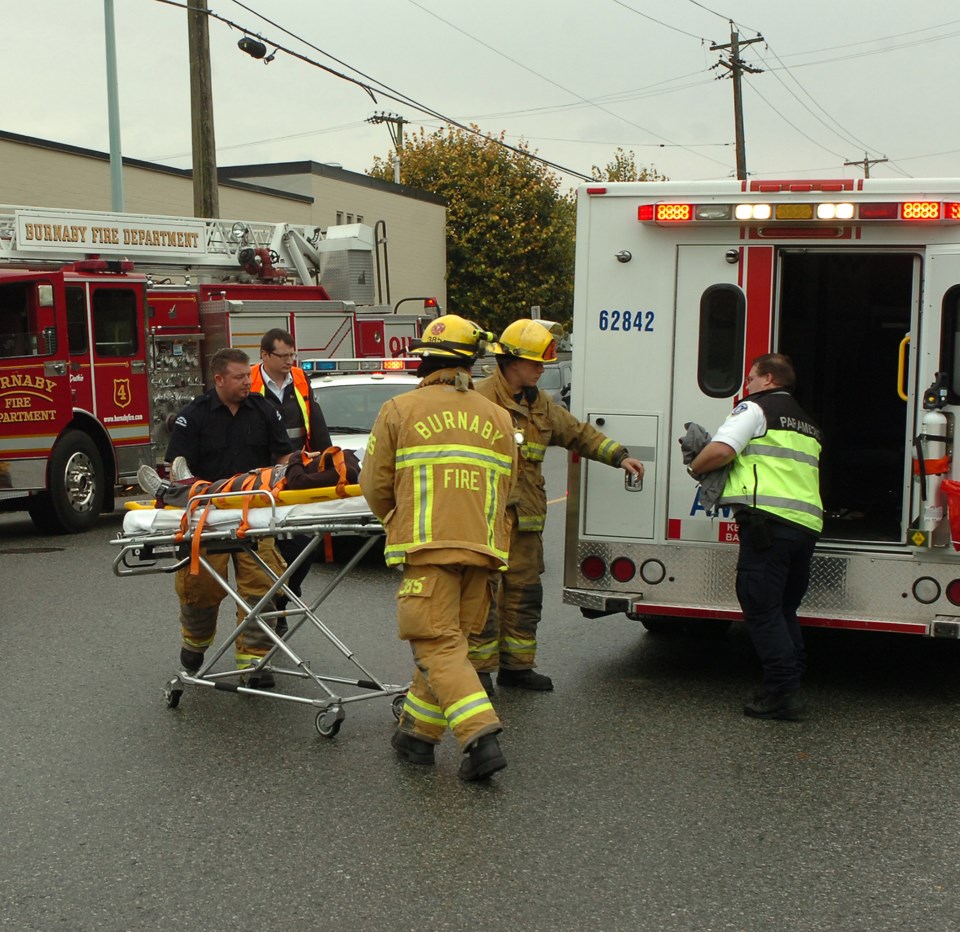Burnaby’s fire chief doesn’t think a 90-year-old woman with uncontrolled bleeding from her head after a fall should have to wait one hour and 23 minutes for an ambulance.
But that’s what happened in January after BC Emergency Health Services (BCEHS) downgraded certain types of medical emergencies last October.
The woman’s case is one of 11 in Burnaby since October in which patients have had to wait more than one hour for paramedics.
There were also 67 incidents of ambulances taking more than half an hour to arrive, and one 60-year-old woman waited for two hours after injuring herself falling down a flight of stairs.
Such wait times, detailed in a Burnaby Fire Department report to BCEHS vice-president William Dick last week, are unacceptable, according to local fire chief Doug McDonald.
“There’s a moral issue here that we should do the right thing, and this is not the right thing,” he said.
BCEHS has been criticized by fire departments around the province since it downgraded 74 types of emergency calls in its resource allocation plan (RAP) from code 3 — lights and sirens — to code 2 — routine.
McDonald said the new policy, which was adopted without input from fire departments, is flawed.
Besides increasing wait times for calls now deemed routine, it ties up firefighter resources, since fire crews still respond to the calls the way they always have and won’t leave a patient at the scene once they arrive.
In a Tuesday press conference defending the new protocol, however, BCEHS officials argued it has shaved 29 seconds off average response time for more urgent, code 3 calls.
They also suggested the “comfort” care firefighters provide on most code 2 calls doesn’t make a difference to patient outcomes.
McDonald was “appalled” by that view.
Besides undermining the emotional value of first-responder care, he said such a suggestion obscures how BCEHS measures patient outcomes.
“What they don’t tell you is that their determination of patient outcomes is the status of the patient when they arrive and the status of the patient when they drop them off at the hospital,” he said. “They don’t look at whether the patient walked out the hospital the next day or whether the patient passed away.”
Its also doesn’t take into account the medical interventions performed by first responders before paramedics arrive.
Dick acknowledged the data currently used to determine patient outcomes is incomplete but said he was confident data from fire fighters and hospitals would only prove him right.
“I think it’s even going to strengthen my case more,” he said.
Another problem McDonald sees with the new system is the possibility of miscoded calls.
Because call centres often rely on information from bystanders or patients not medically trained, McDonald said there’s a danger of critically injured or sick patients being improperly coded and waiting a long time for paramedics.
And he said there have been calls since October during which firefighters have tried to have code 2 calls upgraded based on information at the scene but BCEHS has kept the code as is.
“We haven’t found out a way to get them to change it yet,” McDonald said.
Dick, however, said the call-taking system BCEHS uses was carefully designed to take information from lay people, and less than one per cent of calls are miscoded.
He also challenges the Burnaby fire chief’s claim that BCEHS won’t upgrade its code based on first responder information from the scene.
“Or policy is that if the first responders are on scene and they think that something’s not right, they get an upgrade. That’s our policy,” he said. “The chief is alleging that this isn’t happening, but I need evidence.”
While McDonald and other fire chiefs want BCEHS to reverse its downgrade of the 74 call types, Dick said that’s unlikely.
“Unless we find evidence that we’ve gotten something wrong, and right now I can tell you we’ve look at 114, 000 patients calls, and we’re getting it right.”
Burnaby-Deer Lake MLA and NDP Public Safety and Corrections critic Kathy Corrigan, however, disagrees.
She plans to take the Burnaby fire chief’s concerns to the provincial legislature.
“I think they need to reverse this and have a good look at it,” she told the NOW. ”Because they haven’t consulted with the fire chiefs, they haven’t consulted with the effected communities, they haven’t consulted with the front-line paramedics, all of whom have expressed deep concern about these changes, I think that means that they need to roll back on this and they need to take a fresh look at it.”



